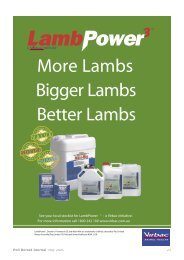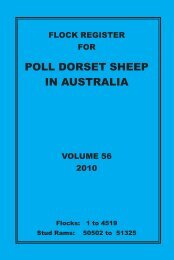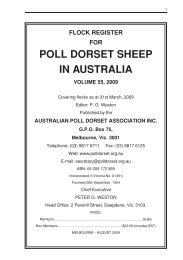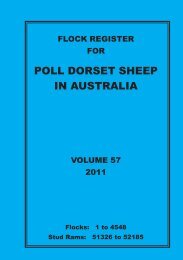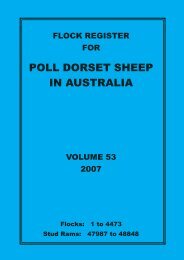2012 flock register vol 58.pdf - Australian Poll Dorset Association Inc
2012 flock register vol 58.pdf - Australian Poll Dorset Association Inc
2012 flock register vol 58.pdf - Australian Poll Dorset Association Inc
Create successful ePaper yourself
Turn your PDF publications into a flip-book with our unique Google optimized e-Paper software.
50<br />
C. INSPECTION OF REGISTERED FLOCK ON OWNER’S PROPERTY<br />
1. Courtesy<br />
Courtesy and mutual understanding should be the keynote of a Flock Inspection.<br />
It should be, and usually is, an interesting and pleasant occasion when two or<br />
three stud breeders get together and chat over <strong>Association</strong> affairs, swap<br />
experiences, check over the Breeders <strong>flock</strong> and discuss his particular problems.<br />
2. Culling<br />
The visiting Inspectors check to see that the <strong>Association</strong> regulations regarding<br />
tattooing, are carried out; that a reasonable standard is being maintained and<br />
may possibly cull one or two animals with dangerous breeding potential as a<br />
guide to the Breeder. But only if necessary.<br />
It is true that some Breeders leave all their culling to the Inspectors, and these<br />
should be treated accordingly. However, most responsible Breeders do their own<br />
classing and culling with great care.<br />
There are some Inspectors who feel that they have not done their job properly<br />
unless they cull a few animals. This attitude is wrong.<br />
3. Flock Assessment<br />
The Inspectors, having examined a Breeder’s entire <strong>flock</strong>, are in a position to<br />
assess the main f lock strengths and weaknesses. No matter how able and<br />
experienced the Breeder, he can benefit from such an assessment from the<br />
visiting Inspectors who gain an overall picture not obvious to the man who lives<br />
with his sheep and sees them daily.<br />
4. Two Suggestions for the Inspector<br />
The Flock Inspector must beware of two pitfalls. Firstly, he must not confuse old<br />
age, or low condition, with poor quality. Secondly, he must realise that the man<br />
who has yarded his <strong>flock</strong> for inspection is proud of his <strong>flock</strong>. Over the years, he<br />
has planned it and bred it. This stud is his creation - and like any other creative<br />
artist displaying his work to another artist - he is sensitive about it. Feelings can<br />
be hurt and resentment aroused by unconstructive or tactless criticism - or by<br />
an officious or dictatorial manner.<br />
5. And Two for the Breeder<br />
On the other hand, the Breeder whose <strong>flock</strong> is being inspected must also realise<br />
certain things.<br />
Firstly, his attitude towards inspections should be governed by the knowledge<br />
that they are of great value to the Breed in the maintenance of Breed standards<br />
and Breed purity; and in engendering confidence in, and demand for, his product.<br />
Secondly, he must realise that the Inspector has been appointed by the<br />
<strong>Association</strong> to do a job, which will cause the Inspector inconvenience, time and<br />
expense; that the Inspector is not doing the job by choice, but in the interests of<br />
the <strong>Association</strong> and the Breed. He should not be taken for granted.<br />
6. Expulsion<br />
Guidance to Breeders and Inspectors<br />
A Breeder who is completely indifferent to the good name of the Breed or the<br />
<strong>Association</strong>, and whose conduct and breeding methods make a farce of<br />
<strong>register</strong>ed stud breeding, does more harm inside the <strong>Association</strong> than out of it.



